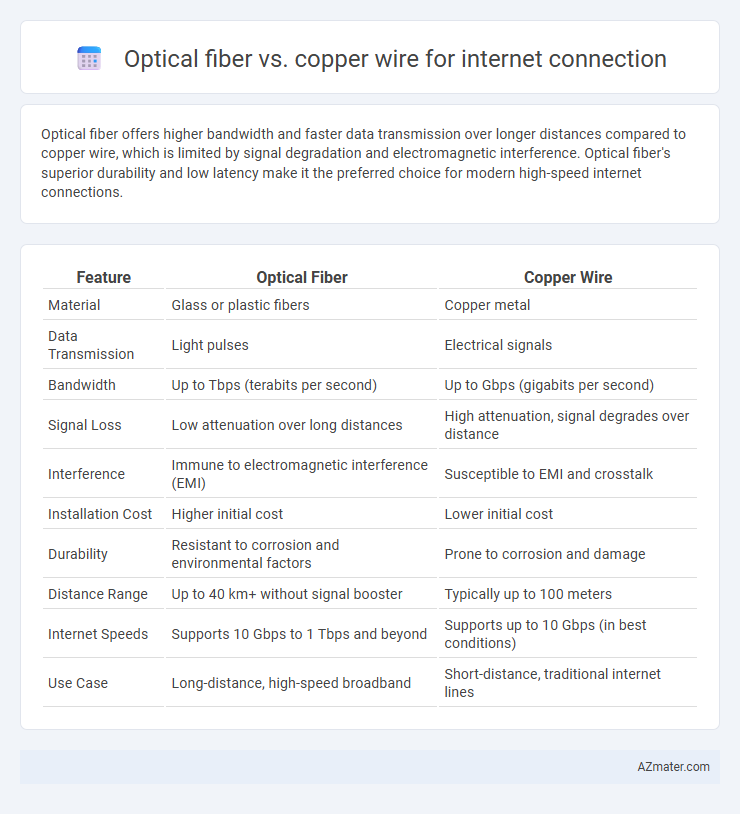Optical fiber offers higher bandwidth and faster data transmission over longer distances compared to copper wire, which is limited by signal degradation and electromagnetic interference. Optical fiber's superior durability and low latency make it the preferred choice for modern high-speed internet connections.
Table of Comparison
| Feature | Optical Fiber | Copper Wire |
|---|---|---|
| Material | Glass or plastic fibers | Copper metal |
| Data Transmission | Light pulses | Electrical signals |
| Bandwidth | Up to Tbps (terabits per second) | Up to Gbps (gigabits per second) |
| Signal Loss | Low attenuation over long distances | High attenuation, signal degrades over distance |
| Interference | Immune to electromagnetic interference (EMI) | Susceptible to EMI and crosstalk |
| Installation Cost | Higher initial cost | Lower initial cost |
| Durability | Resistant to corrosion and environmental factors | Prone to corrosion and damage |
| Distance Range | Up to 40 km+ without signal booster | Typically up to 100 meters |
| Internet Speeds | Supports 10 Gbps to 1 Tbps and beyond | Supports up to 10 Gbps (in best conditions) |
| Use Case | Long-distance, high-speed broadband | Short-distance, traditional internet lines |
Introduction: Optical Fiber vs Copper Wire
Optical fiber offers significantly higher bandwidth and faster data transmission compared to copper wire, making it ideal for modern high-speed internet connections. While copper wire connections, such as DSL and coaxial cables, are more susceptible to signal degradation and electromagnetic interference, optical fiber uses light signals that maintain integrity over longer distances. The durability and future-proof nature of optical fiber network infrastructure have led to its increasing adoption in both residential and commercial internet services.
Speed and Bandwidth Capabilities
Optical fiber offers significantly higher speed and bandwidth capabilities compared to copper wire, supporting data rates up to 100 Gbps and beyond with minimal signal loss over long distances. Copper wire, typically limited to speeds of 1 Gbps with technologies like VDSL or coaxial cable, experiences greater attenuation and electromagnetic interference, reducing performance. Fiber optic technology's superior capacity and low latency make it the preferred choice for high-speed internet connections, especially in data-intensive applications and network backbones.
Signal Transmission and Distance
Optical fiber offers superior signal transmission quality compared to copper wire due to its use of light pulses, which experience minimal signal loss and immune interference over long distances. Copper wire, relying on electrical signals, suffers from higher attenuation and electromagnetic interference, restricting reliable data transmission to shorter distances, typically under 100 meters for Ethernet cables. Consequently, optical fiber supports high-speed Internet connections over kilometers without signal degradation, making it ideal for backbone networks and long-range data communication.
Reliability and Interference Resistance
Optical fiber provides superior reliability and interference resistance compared to copper wire, as it transmits data using light signals that are immune to electromagnetic interference (EMI) and radio frequency interference (RFI). Copper wire often experiences signal degradation and data loss due to susceptibility to EMI from nearby electrical devices and weather conditions. This makes optical fiber the preferred choice for stable, high-speed internet connections in environments with high electrical noise.
Installation Process and Flexibility
Optical fiber installation requires specialized equipment and skilled technicians to handle delicate glass strands and precise splicing, often leading to higher initial costs compared to copper wire. Copper wire installation is generally simpler and more flexible, allowing for easier routing through existing conduits and quicker deployment in various environments. Despite the complexity, optical fiber offers superior scalability and future-proofing for high-speed internet networks, while copper wire provides adequate performance for shorter distances with easier maintenance and modification.
Cost Comparison: Upfront and Long-Term
Optical fiber installation typically has a higher upfront cost due to expensive materials and specialized labor, but offers lower maintenance and higher bandwidth efficiency over time. Copper wire systems are cheaper initially but often incur higher long-term expenses because of signal degradation, frequent repairs, and limited data capacity. Choosing fiber optic technology maximizes cost-effectiveness in high-speed internet infrastructure by reducing operational costs and supporting future bandwidth demands.
Security and Data Protection
Optical fiber provides superior security and data protection compared to copper wire due to its resistance to electromagnetic interference and difficulty in tapping without detection. Fiber optic cables transmit data as light pulses, making it nearly impossible for hackers to intercept or alter signals without causing noticeable disruption. Copper wire, susceptible to electromagnetic interference and easier physical access, presents higher risks of data breaches and signal interference in internet connections.
Maintenance and Durability
Optical fiber offers superior durability with resistance to electromagnetic interference and corrosion, reducing the frequency of maintenance compared to copper wire. Copper wires are more prone to signal degradation, physical wear, and environmental damage, necessitating frequent repairs and replacements. Maintenance costs for optical fiber networks are generally lower due to their longer lifespan and robustness in harsh conditions.
Environmental Impact
Optical fiber internet connections generate significantly lower carbon emissions compared to copper wire due to their energy-efficient data transmission and longer lifespan. Copper production involves extensive mining and refining processes that contribute to environmental degradation and higher greenhouse gas emissions. Recycling optical fiber materials is more sustainable, reducing electronic waste and minimizing ecological footprints in network infrastructure.
Future-Proofing: Scalability and Upgrades
Optical fiber offers superior scalability and future-proofing for internet connections due to its high bandwidth capacity and ability to support faster data rates over longer distances without signal degradation. Copper wire, while widely deployed, faces limitations in speed and interference, making upgrades costly and less effective as demand for higher internet speeds grows. Investing in optical fiber ensures seamless integration with emerging technologies and easier upgrades to meet increasing data demands.

Infographic: Optical fiber vs Copper wire for Internet connection
 azmater.com
azmater.com